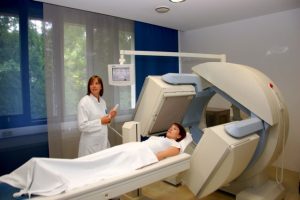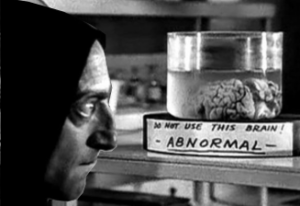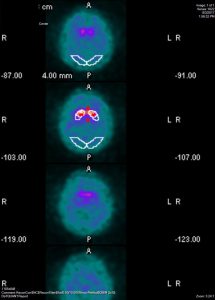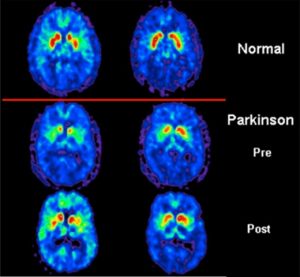DaTscan for Parkinson’s
It was not easy to get the DaTscan prescribed. From our research and what the neurologist told me, a DaTscan is the only method that can tell the doctor if symptom treatment with prescription drugs should be pursued. I had every single symptom of Parkinson but, doctors were not going to even hint that it was Parkinson’s Disease without a DaTscan. I was initially diagnosed with anxiety but, my husband and I both knew it was something far worse.
Severe anxiety can in fact cause many Parkinson like symptoms but, after raising five kids, I think we both can cope pretty well and both know anxiety quite well on a personal level 😉 . So, I began seeing a wonderful psychologist, who even worked with us on cost (Lindsey Harrison at The Costello Center). I was able to focus and cope with the anxiety caused by Parkinson. At work, my shaking and inability to move, type or get comfortable was overwhelming and the coping, calming methods my psychologist showed me really did help. 
My husband told me, and neurologist confirmed, its not a good idea to take any supplements when on Parkinson medication because drug interaction is not known in many cases. Even your daily multivitamin can prevent the medication from working or interact negatively. Iron in your multivitamin? Not good. So, I am not taking supplements currently but, plan to in the future as we do more research and share / confirm our findings with the doctor so I possibly can.
The scan costs from $3600 to $3800 dollars if you pay out of pocket. I dont know what the cost is if you are well off enough to have insurance. We were luck enough to qualify for a free scan through the wonderful Baycare Financial Assistance. My scan was performed at Carlisle Imaging Center in Clearwater FL. There are other imaging centers & services closer to our home but, I have had all good experiences in the Morton Plant Hospital area of services and the Carlisle Imaging Center was really great and stress free even for my husband. Parking was covered, easy and free. Within less than a block of walking, there is food options and a thrift store to help pass the three hours without moving the car. Even a picnic table in the shade should you want to have a picnic. There is free WiFi as well.
There is an iodine based and nuclear injections. I then came back three hours later for the scan. I am VERY claustrophobic so, if you have such difficulties, tell them way ahead of time and you can get a Valium. They ask you to get there about an hour early to give it to you should you require one. My husband was able to sit with me during the 35 minute procedure to hold my hand and ankle for my comfort. Also a towel was placed over my face which also helped a lot. The machine was very quit and there was soothing music playing in the background.
Here is some copy and paste info on DaTscan:
What is the role of DaTscan for Parkinson’s disease? During a diagnosis you may hear of this imaging test or be asked to undergo one.
While DaTscans cannot diagnose Parkinson’s disease, the imaging technology may provide beneficial insights to help a doctor confirm a PD diagnosis in the early stages of the disease.
To answer your questions and more about DaTscan, browse this question and answer session done with the help of James Beck, Ph.D., PDFs Vice President, Scientific Affairs.
Q: What is DaTscan?
Dr. Beck: DaTscan is an imaging technology that uses small amounts of a radioactive drug to help determine how much dopamine is available in a persons brain. A machine similar to, but smaller than an MRI machine, called a single photon emission computed tomography or SPECT scanner, measures the amount and location of the drug in the brain.
The use of DaTscan was approved by the US Food and Drug Administration (FDA) in 2011.
Q: Can DaTscan diagnose Parkinson’s?
Dr. Beck: DaTscans cannot diagnose Parkinson’s disease. These scans are used to help a doctor confirm a diagnosis. DaTscan has been used in Europe for over 10 years, where more than 300,000 have undergone the procedure. The results of a DaTscan can be used to help rule out other diseases that may have similar symptoms, like essential tremor, especially for individuals early in the course of their disease. However, there are several other diseases, multiple system atrophy (MSA) or progressive supranuclear palsy (PSP), which can also produce a loss of dopamine in the brain. A DaTscan cannot differentiate between those diseases and Parkinson’s.
Q: What is the role of the DaTscan for people living with Parkinson’s?
Dr. Beck: Currently, there is no objective test for Parkinson’s disease. While the specificity and sensitivity of DaTscans are not 100 percent, the test can help doctors to confirm or refute their suspected diagnosis. DaTscans will therefore be helpful in people whose symptoms present an inconclusive or confusing diagnosis.
Q: Are there risks associated with DaTscan?
Dr. Beck: Possible adverse reactions such as headache, nausea, vertigo, dry mouth, and mild to moderate dizziness were reported, hypersensitivity reaction and injection site pain have been reported. Among the individuals who have undergone the DaTscan in Europe, no significant side-effects have been reported.
Q: I have Parkinson’s / I am experiencing symptoms of Parkinson’s. Should I get a DaTscan?
Dr. Beck: Likely no. Individuals who respond well to Parkinson’s medication therapy and who have been diagnosed for many years will likely have an accurate diagnosis of Parkinson’s disease. A DaTscan may be useful for those whose diagnosis is clinically uncertain or who have failed to respond well to common Parkinson’s medication therapy. Every case of Parkinson’s disease is different, so it is important to discuss it with your doctor.
Q: How can I get a DaTscan?
Dr. Beck: PDF recommends speaking with your doctor to see if a DaTscan is right for you. Those interested in learning more can visit GE Health Care DaTscan and you can find your local facility for a DaTscan here.
Q: Is the DaTscan test covered by insurance, Medicare and Medicaid?
Dr. Beck: DaTscan will be covered by Medicare and Medicaid. Insurers are likely to cover Datscan but insurers vary, so please contact your insurer for more information.
Source Parkinson’s Disease Foundation, Inc.
In 2011, the FDA approved DaTscan (Ioflupane I 123 injection, also known as phenyltropane), a radiopharmaceutical agent which is injected into a patient’s veins in a procedure referred to as SPECT imaging. DaTscan is an important addition because it is anticipated to be more widely available than other techniques and it has received several major endorsements from leading scientists.
One of the most frequently asked questions about Parkinson’s disease on NPF’s “Ask the Doctor” web-based forum is whether or not to pursue DaT or PET scanning to confirm a diagnosis of Parkinson’s disease. In this month’s What’s Hot column, we offer a review of the subject in light of the recent FDA approval.
If you have already received a diagnosis from an expert, and are responding well to dopaminergic therapy, in most cases of Parkinson’s disease, PET and SPECT scans would not add any new information and therefore likely to be unnecessary. In cases where the expert is not sure of the diagnosis – is it essential tremor or Parkinson’s, for example– or where a potentially risky procedure is being considered (e.g. deep brain stimulation surgery), it is reasonable for your doctor to recommend a PETscan or DaTscan. It is important to keep in mind that PET and SPECT scans should be performed only by experienced neurologists who have executed a large volume of Parkinson’s disease scans, because experience is important in accurately reading these imaging results.
Here is how it works: First, the person receives an injection of the imaging agent. After injection, the compound can be visualized by a special detector called a gamma camera. This so-called scan measures something called the dopamine transporter (DaT), and it can help a doctor determine if patients are suffering from essential tremor, vs. Parkinson’s disease or another parkinsonism (i.e., other problems affecting dopamine systems that have symptoms of Parkinson’s disease). . The side effects are minimal (e.g. headache, dizziness, increased appetite and creepy crawly feeling under the skin). PET scans and DaT/SPECT scans examine the function of the brain rather than its anatomy. This is an important point because unlike in strokes and tumors, the brain anatomy of a Parkinson’s disease patient is largely normal. These scans can show changes in brain chemistry, such as a decrease in dopamine, which identify Parkinson’s disease and other kinds of parkinsonism. There are several compounds available for use in both PET and SPECT scanning; however PET scans typically focus on glucose (sugar) metabolism, and DaT/SPECT scans focus on the activity of the dopamine transporter.
The new DaT scans use a substance that tags a part of a neuron in the brain where dopamine attaches to it, showing the density of healthy dopamine neurons. Thus, the more of the picture that lights up, the more surviving brain cells. If the parts of the brain where dopamine cells should be remain dark in the scan, an expert reader may diagnose early brain degeneration. This could mean either Parkinson’s disease or parkinsonism.
In Parkinson’s disease, people will lose cells in a part of the brain associated with movement referred to as the basal ganglia. There is a common pattern seen in people with Parkinson’s, with the cell loss starting on just one side, towards the back of the basal ganglia, and deep down. Over time, the affected area spreads across the basal ganglia. However, as part of the normal aging process, it is completely normal to lose some of these cells—therefore it takes an expert to read these scans and figure out if the changes are due to normal aging or due to disease. There are typical scan patterns that may emerge. The more widespread the decrease in uptake on the scan, the more advanced the degeneration.
Interpretations can, however, be tricky. The first determination is whether the scan is normal or abnormal. Next, the expert will determine if the scan follows the pattern of Parkinson’s disease. Finally, a determination will be made as to the severity of the brain cell loss. There are only a few centers that regularly perform very high quality PET scans for Parkinson’s disease, and these centers usually have experts in interpretation. Two centers with leading reputations include Long Island Jewish Hospital in New York (North Shore) and Washington University Hospital in St. Louis, although there are others.
PET scans are FDA-approved for the diagnosis of dementia, but not for the diagnosis of Parkinson’s disease. However, if you or your relative has cognitive impairment, the scan can be ordered to examine for the presence of Alzheimer’s changes as Parkinson’s disease often co-occurs with Alzheimer’s. The cost can range from $2,500-5,000. Many expert centers perform PET scans for free under research protocols.
Recently, in studies that have attempted to diagnose Parkinson’s early in its course, researchers have found that a subset of patients thought to have Parkinson’s disease have turned up with negative PET or SPECT scans. These patients do not seem to develop the progressive symptoms of Parkinson’s disease. These findings are humbling, and they lend credence to the importance of following patients over long periods of time to ensure both accurate diagnosis, and also appropriate treatment.
An example DaTscan is shown below and it demonstrates essential tremor on the left (normal DaT), and a parkinsonian syndrome on the right (decreased DaT).

An example of a PET scan is below and it reveals: in the top panel a normal scan, in the middle panel abnormalities in the putamen (red uptake in the figure) in a patient with Parkinson’s disease, and in the lower panel a return to an almost normal scan following the introduction of levodopa.

In conclusion, in cases where the diagnosis is uncertain (e.g. Parkinson’s disease versus essential tremor), a DaT or PET scan can be very useful. But patients and their families need to be aware that in general, these scans cannot reliably separate Parkinson’s disease from parkinsonism (multiple system atrophy, corticobasal degeneration, progressive supranuclear palsy), and thus if you seek a scan you will still need an expert to sort out your clinical picture and diagnosis. If you have already been diagnosed, if your symptoms are progressing, and you have an adequate response to medications, most likely a PET or DaTscan would add little new information and therefore not be necessary.
Selected References
Okun, M.S., Fernandez H.H. Ask the Doctor About Parkinson’s Disease. Demos Medical Publishing, 2009.
Kägi G, Bhatia KP, Tolosa E. The role of DAT-SPECT in movement disorders. J Neurol Neurosurg Psychiatry. 2010 Jan;81(1):5-12. Review.
Booij J, Knol RJ. SPECT imaging of the dopaminergic system in (premotor) Parkinson’s disease. Parkinsonism Relat Disord. 2007;13 Suppl 3:S425-8. Review.
Stoessl AJ. Positron emission tomography in premotor Parkinson’s disease. Parkinsonism Relat Disord. 2007;13 Suppl 3:S421-4. Review.
Scherfler C, Schwarz J, Antonini A, Grosset D, Valldeoriola F, Marek K, Oertel W, Tolosa E, Lees AJ, Poewe W. Role of DAT-SPECT in the diagnostic work up of parkinsonism. Mov Disord. 2007 Jul 15;22(9):1229-38. Review.